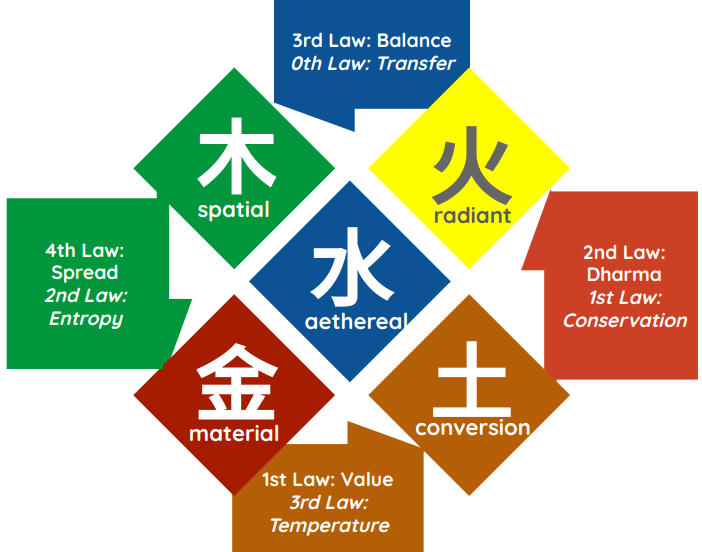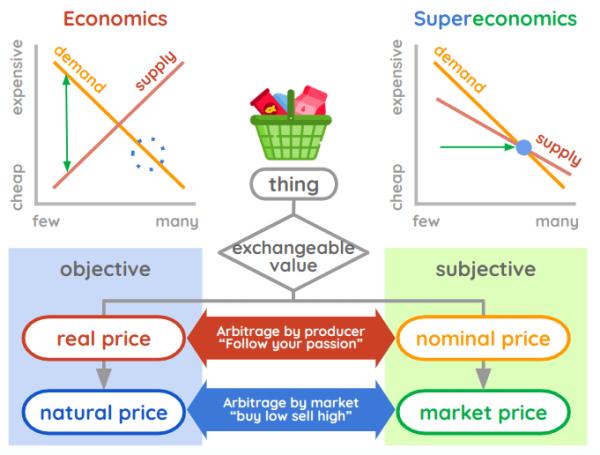Chapter 5


The Four Laws Table
by Juan
3 min read
516 words
Table of Contents
Supereconomics classifies value into buyer-seller, and personal-societal, leading to 4 kinds of value.
| Supereconomics | Personal | Society |
|---|---|---|
| Subjective and Variable (Buyer’s perspective) | Nominal Price (value in currency) | Market Price (value to the buyer) |
| Objective and Natural or Invariable (Seller’s perspective) | Real Price (value in grain or labour) | Natural Price (value to the seller) |
Economics, on the other hand, has no concept of Real and Natural Price because it has no concept of society as an objective entity.
- It purposely rejects the importance of society because it enshrines selfishness, as a result of being dominated by the Negative Force.
- This Negative Force also facilitates division, crudity as materialism, war, conflict, racism, etc.
To pursue selfishness, Economics teaches:
- arbitrage
- profit maximization
- finance and money-only exchange
- private sensory pleasures.
As a result, it only has:
- economic value (nominal price)
- market value (market price)
| Economics | Personal | Society |
|---|---|---|
| Subjective and Variable | Nominal Price (value in currency) | Market Price (value to the buyer) |
We can now summarize and organize our 4 prices into a pattern:
| Law | Price | Purpose |
|---|---|---|
| 1 | Nominal | Utilization - exposes the lack and the need |
| 2 | Real | Specialization - drives action to increase quality and quantity to deal with the lack |
| 3 | Natural | Balance - prevents the crashes that leads to a recurrence of lack |
| 4 | Market | Diffusion - spreads quality and quantity to address the lack |
We find that it exactky matches the Law of Social Cycles of Supersociology:
| Cycle | Price |
|---|---|
| Worker | Nominal |
| Warrior | Real |
| Thinker | Natural |
| Trader | Market |
From here, we can connect Supereconomics with Supersociology by making them the Four Laws of Value.
| Law | Price | Meaning |
|---|---|---|
| 1 | Nominal | Everything in the universe has value |
| 2 | Real | Value is created to address lack |
| 3 | Natural | There must be balance in the creation and spread of value |
| 4 | Market | Value is spread through fair exchange |
Since we equate value to desire and desire in the physical domain is energy, then we can connect these 4 laws to the laws of thermodynamics:
| Supereconomics Law | Physics Thermodynamics Law |
|---|---|
| 1 - Nominal | 3 - A system’s entropy reaches a constant value as its temperature reaches absolute zero |
| 2 - Real | 1 - Energy can be conerted from one form to another, but cannot be created nor destroyed |
| 3 - Natural | 0 - If 2 systems are in thermal equilibrium with a 3rd system, then they are in equilibrium with each other |
| 4 - Market | 2 - Entropy will always increase over time |

- The 2nd and 1st law of thermodynamics refer to the external aspects of waves just as the Market and Real Price are objective
- The 3rd and 0th laws refer to the internal aspects just as the Nominal and Market Price are subjective

Updates
| 4/2017 | added Economics value matrix |
|---|---|
| 8/2020 | overhauled to match Superphysics |
| 7/2021 | overhauled to base everything on the four laws |
| 2/2022 | Added the four classes (Worker, Warrior, Philosopher, Merchant) onto the four laws |
| 3/2024 | Put the 4th Law as the 2nd to explain the priorness of politics over economics, or Supersociology over Supereconomics |
| 8/2024 | Put the 4th Law as the 3rd Law after connecting it again with Thermodynamics |